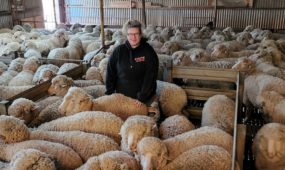Why farmers are trading water on their cell phones
Primary Industries
TEN years of drought isn’t a good thing. It doesn’t help the bottom line of farmers or the health of a river system. It does, however, get a lot of minds focused on how to intelligently manage water – the world’s most precious commodity.

Sign up to receive notifications about new stories in this category.
Thank you for subscribing to story notifications.
Irrigators in Australia receive a yearly allocation of water that they can use for cropping or production. It's measured in megalitres, isn't tied to their property, and can be traded to other farmers on a per year basis, or as a permanent right.
This is basically a bank account – a water account – says Alister Walsh, the CEO of the uniquely Australian water brokerage Waterfind.
“If you buy water in, you get credited with volume”, he says. “If you sell, it gets debited.”
Farmers are actually very early adopters of technology, particularly mobile technology.
Of course, the water being traded isn't physically shifted down a river for a trade – it's a clever accounting system that ensures water use goes through proper checks and balances and the river system is maintained at a healthy level, without over-appropriation or environmental degradation. It also gives value to the precious commodity so farmers are more inclined to invest in saving water because they have the option of selling their surplus.
The water market has existed in South Australia since the 1980s, but it wasn't until Tom Rooney founded Waterfind in 2002 that an easy online mechanism existed to trade the resource.
Waterfind's online water trading market was launched two years in to the Millennium Drought, Australia's worst in recorded history. It operates in much the same way as any other commodity market – allowing farmers to make trades online or via SMS at any time of day, following all the rules and regulations so users don't have to.
“Farmers, though it might not always seem it, they're actually very early adopters of technology, particularly mobile technology. That's because they're not in their office. They're out and about and on the tractor doing their banking and responding to emails,” Walsh explains.
Waterfind won the Water Industry Alliance Innovation Award in 2006 for their work on the online market, and again in 2010 for integrating an SMS mobile alert and trading system in to their markets. A recent update has also made their online markets mobile-friendly.
“Being in a position where we can offer our market in the same format regardless if they're sitting on the PC at home or out on the tractor, that's really important. There's no inconsistency between the markets.”
Benefits of the water trading scheme
The revelation of putting a transparent price point on water has had many flow on effects for water management in Australia. Structural efficiencies have emerged and businesses have matured. It incentivises being smart with water.
According to Walsh, irrigators have invested in more efficient delivery systems and moved away from flood irrigation. They've laser levelled their properties and installed efficient spray and drip delivery.
“There's broadacre production irrigated by underground drip systems – that's hugely more efficient than traditional methods, in the order of 50% of more,” says Walsh. “It enables two things, for growers to do more with what they had, or they don't need the same level of water input to meet their requirements.”
With water being treated as an input cost rather than a permanent right such as the prior-appropriation systems in the United States, annual crops like rice can mostly rely on cheap temporary trades when water is plentiful. Rice farmers can not sow during drought conditions and get an income by selling off the unused water allocations for those years.
Long-term investments such as fruit orchards are able to invest in high-security permanent allocations that provide the baseline of water needed to maintain their trees even during periods of high water prices.
Even during the worst years of drought, when water available for use in Australia dropped by 53% between 2005 and 2009, the gross value of irrigated agricultural production only dropped by 29%, a signal for the efficiencies built in to the system.
Water allocation trading also allowed the government to buy back water through a market based system, gradually taking the resource out of the hands of irrigators over time, allowing them to restructure, and allowing water to be put to environmental uses to ensure the long-term health of river systems and water basins.
FuturesWaterfindcentre
They also launched their forwards market in March of 2014, allowing trades to be conducted ahead of time.
“It allows people to lock in a volume of allocation delivery at a price at a particularly delivery date,” says Walsh. “Forwards enable our customers to hedge or offset a bit of risk as far as water use, to position themselves for a new year.”
The company won their third Innovation Award from the Water Industry Alliance for their work on the forward water market.
“It was really interesting to see how accurate – or not – people were in the first year of trading. Generally the forwards are done on large volumes, those with larger holdings that are in a secure position, more sophisticated water users,” Walsh says.
It also allows smaller buyers and sellers to have a more educated guess about the year ahead.
Waterfind sees opportunities to help the farmers in the United States manage their water
Australia is more regulated when it comes to water use. Landholders don't own anything more than fifteen centimetres below the surface and groundwater is strongly monitored.
“In California it's basically just go your hardest. It's whoever can bore the quickest,” says Walsh. “They haven't had access to surface water, so they've turned to their groundwater and they're depleting aquifers. They're shifting in depth by hundreds of feet in just a couple of years.”
Though the scale of agriculture and the conditions of the drought are different, the systems used to manage the water can still be compared.
Walsh says that Australia has already lived through the pain being experienced in California, for example.
“We had three or four incredibly difficult years, but through the use of markets and other mechanisms, made it through,” he says. “There [in California] it's gone from go to woah in three years. There's lots of opportunities in lots of states and the scale of their resource is significantly bigger than what we have in Australia.”
“Even if people don't engage with them, they now know the intrinsic cost of the resource. It helps them in their thinking and planning.”
He’s hoping that in the near future the sight of farmers buying and selling water on their cell phones becomes as common a sight in North America as it is in Australia.
Jump to next article



